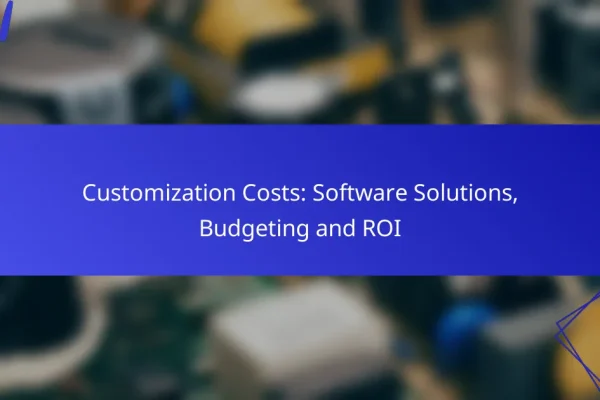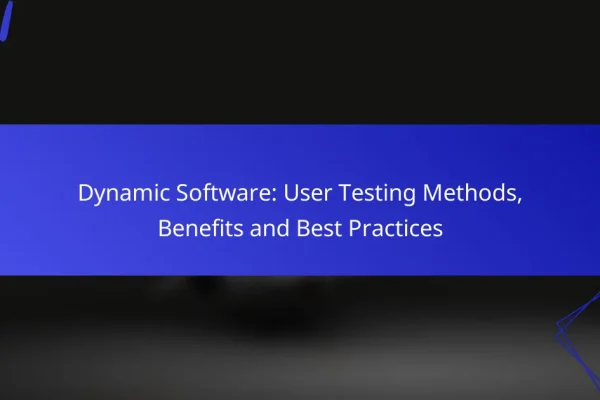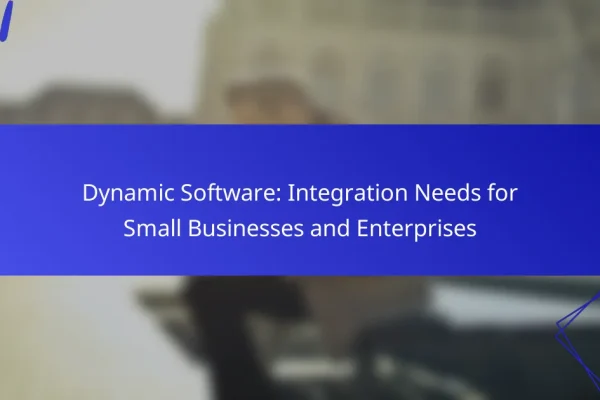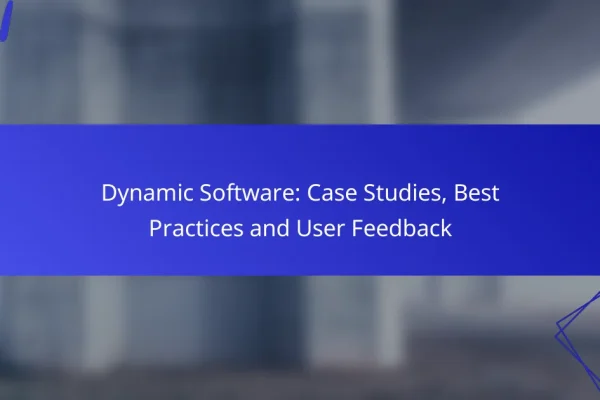
Customization Costs: Software Solutions, Budgeting and ROI
Customization costs for software solutions in e-commerce can significantly impact a business’s budget and overall…
Dynamic software solutions are essential for achieving e-commerce success, offering the flexibility and scalability needed to adapt to changing market demands. By integrating advanced technologies, businesses can create personalized shopping experiences, efficiently manage inventory, and foster meaningful customer connections.

Customization costs for software solutions in e-commerce can significantly impact a business’s budget and overall strategy. Understanding these costs, which include development, maintenance, and integration fees, is crucial for effective financial planning. By carefully budgeting for these expenses, businesses can ensure they achieve a favorable return on investment through enhanced efficiency and improved customer satisfaction….

Security metrics play a crucial role in assessing and enhancing an organization’s cybersecurity posture. By effectively measuring relevant indicators and analyzing data, organizations can align their security efforts with strategic goals and make informed decisions. Clear and regular reporting of these metrics ensures that stakeholders are well-informed about security performance and can respond appropriately to…

When budgeting for dynamic software, both small and large teams face unique challenges and opportunities. Small teams can optimize their budgets by utilizing cost-effective tools and open-source solutions, while larger teams must navigate the complexities of enterprise solutions and custom development. Understanding the total cost of ownership is crucial for both, as it encompasses all…

Customization plays a crucial role in enhancing user experience by providing tailored interactions that align with individual preferences and needs. This personalized approach not only boosts engagement but also fosters deeper connections between users and brands, ultimately leading to higher satisfaction and loyalty. How does customization enhance user experience in e-commerce? Customization significantly enhances user…

Dynamic software performance is assessed through key metrics such as response time, throughput, and user satisfaction, which collectively offer insights into its effectiveness and reliability. By employing measurement techniques like performance audits and A/B testing, developers can ensure that their applications not only function optimally but also align with user expectations. Understanding these metrics is…

Customization plays a crucial role in enhancing software performance by aligning applications with user-specific needs and workflows. This tailored approach not only improves efficiency but also boosts user satisfaction, as individuals can adapt software functionalities to better suit their preferences. As a result, organizations can streamline operations and create a more positive user experience. How…

User testing is a critical component in the development of dynamic software, providing valuable insights into user behavior and preferences. By employing methods such as usability testing, A/B testing, and remote user testing, developers can identify pain points and enhance functionality, ultimately leading to improved user satisfaction. This systematic approach ensures that the software effectively…

Dynamic software integration is essential for both small businesses and enterprises, as it enhances operational efficiency by connecting various applications and systems. By facilitating real-time data exchange and streamlining processes, these integration solutions reduce manual tasks and improve collaboration across departments. This adaptability not only boosts productivity but also ensures that businesses can respond swiftly…

Dynamic software solutions offer businesses the opportunity to enhance efficiency and reduce costs through automation and real-time insights. By examining cost comparisons, case studies, and market trends, organizations can better understand the value these technologies provide and make informed decisions about their software investments. As industries continue to evolve, the adaptability and effectiveness of dynamic…

This document explores the impact of dynamic software through case studies, best practices, and user feedback. By examining how flexible methodologies and real-time adaptability enhance e-commerce operations, we highlight strategies that lead to improved customer experiences and increased sales. The insights gathered will provide valuable guidance for teams looking to implement dynamic software effectively. What…
Dynamic software solutions enhance e-commerce success by providing flexibility, scalability, and integration capabilities. These tools help businesses create tailored shopping experiences, manage inventory efficiently, and connect with customers effectively.
Shopify is a leading platform for creating customizable online stores. It offers a wide range of themes and apps that allow businesses to tailor their storefronts to match their brand identity and customer preferences.
When using Shopify, consider its user-friendly interface and robust support system, which can help you set up your store quickly. However, be mindful of transaction fees that may apply if you don't use Shopify Payments.
BigCommerce is designed for businesses looking to scale their operations without compromising performance. It supports a variety of sales channels, including social media and marketplaces, making it easier to reach a broader audience.
With built-in SEO features and advanced analytics, BigCommerce helps optimize your online presence. However, its pricing can be higher than some competitors, so evaluate your budget against your growth plans.
WooCommerce is a powerful plugin that transforms WordPress sites into fully functional e-commerce stores. It allows for extensive customization and is ideal for businesses already using WordPress for their content management.
Consider the ease of integration with existing WordPress themes and plugins, but be prepared to manage hosting and security yourself. This can lead to additional costs and responsibilities, so weigh these factors carefully.
Magento is a robust platform tailored for larger enterprises that require extensive customization and flexibility. It supports complex product catalogs and multiple store views, making it suitable for global businesses.
While Magento offers powerful features, it requires a higher level of technical expertise to manage. Businesses should consider investing in skilled developers to fully leverage its capabilities, which can increase overall costs.
Salesforce Commerce Cloud integrates seamlessly with Salesforce's CRM, providing a unified view of customer interactions. This integration allows businesses to personalize marketing efforts and enhance customer engagement.
Utilizing this platform can streamline operations and improve customer service, but it may come with a steep learning curve and higher costs. Ensure your team is prepared for the transition to maximize the benefits of this powerful tool.
Dynamic software solutions significantly enhance customer experience by providing tailored interactions and efficient processes. These technologies leverage data to create personalized shopping journeys, streamline transactions, and ensure accessibility across devices.
AI algorithms analyze customer behavior and preferences to deliver personalized recommendations. By utilizing data from previous purchases and browsing history, e-commerce platforms can suggest products that align with individual tastes, increasing the likelihood of conversion.
Consider implementing machine learning models that continuously adapt to user interactions. This ensures that the personalization remains relevant and effective over time, fostering customer loyalty and satisfaction.
A streamlined checkout process reduces cart abandonment rates and enhances customer satisfaction. Features such as one-click purchasing, saved payment methods, and guest checkout options simplify the transaction, making it quicker and more user-friendly.
To optimize your checkout, focus on minimizing the number of steps required to complete a purchase. Aim for a process that takes no more than a couple of minutes, as lengthy checkouts can deter potential buyers.
Mobile optimization is crucial for catering to customers who shop on their smartphones or tablets. A responsive design ensures that your e-commerce site functions seamlessly across various screen sizes, providing an enjoyable shopping experience.
Ensure that your mobile site loads quickly, ideally within a few seconds, and that navigation is intuitive. Incorporating mobile-specific features, such as touch-friendly buttons and easy access to customer support, can further enhance the shopping experience for on-the-go users.
Effective e-commerce software should include features that streamline operations, enhance customer experience, and provide actionable insights. Key functionalities include inventory management, multi-channel selling integration, and robust analytics tools.
Inventory management capabilities are crucial for maintaining optimal stock levels and ensuring product availability. Effective software should allow real-time tracking of inventory, automatic stock updates, and alerts for low stock levels.
Consider systems that support barcode scanning and integration with suppliers to automate reordering processes. This can help reduce the risk of stockouts and overstock situations, which can be costly for businesses.
Multi-channel selling integration enables businesses to sell across various platforms, such as their own website, Amazon, eBay, and social media. This feature helps reach a broader audience and increases sales opportunities.
When choosing e-commerce software, look for solutions that provide seamless integration with multiple sales channels. This ensures consistent product listings, pricing, and inventory management across all platforms, simplifying operations.
Robust analytics and reporting tools are essential for understanding customer behavior and sales performance. Effective e-commerce software should offer insights into sales trends, customer demographics, and website traffic.
Utilize these analytics to make data-driven decisions, such as optimizing marketing strategies or adjusting inventory levels. Look for software that provides customizable reports to focus on metrics that matter most to your business.
Choosing the right software for your e-commerce business involves assessing your specific needs, growth potential, and how well the software integrates with your current systems. Prioritize solutions that can scale with your business and offer robust support and resources.
Understanding your business size and potential for growth is crucial when selecting e-commerce software. Small businesses may benefit from simpler, cost-effective solutions, while larger enterprises might require more complex platforms that can handle high traffic and extensive product catalogs.
Consider your projected growth over the next few years. If you anticipate significant expansion, opt for software that can easily scale, such as platforms that offer modular features or flexible pricing plans based on sales volume.
Integration capabilities are essential for ensuring your e-commerce software works seamlessly with your existing systems, such as inventory management, accounting, and customer relationship management (CRM) tools. Look for software that supports popular integrations or offers APIs for custom solutions.
Assess the compatibility of potential software with your current technology stack. A solution that easily integrates can save time and reduce operational disruptions, while a lack of integration may lead to inefficiencies and increased costs.
Robust customer support and active community resources can significantly enhance your experience with e-commerce software. Look for providers that offer 24/7 support, comprehensive documentation, and active user forums where you can seek advice and share experiences.
Evaluate the availability of training materials and tutorials as well. Software that provides extensive resources can help you and your team maximize the platform's capabilities, ultimately leading to better performance and customer satisfaction.
The costs associated with e-commerce software solutions can vary widely based on the platform and features chosen. Key expenses include subscription fees, transaction fees, and additional costs for plugins and themes that enhance functionality.
Subscription fees for e-commerce platforms, such as Shopify, typically range from around $29 to $299 per month, depending on the plan selected. Basic plans offer essential features, while higher-tier plans provide advanced tools and support.
When choosing a subscription, consider the features you need, such as payment processing, inventory management, and customer support. Some platforms may offer discounts for annual payments, which can reduce overall costs.
Transaction fees are charged based on the sales volume processed through the e-commerce platform. These fees can range from 1% to 3% per transaction, depending on the payment processor and the subscription plan.
To minimize transaction costs, consider using the platform's built-in payment processor, which often has lower fees compared to third-party options. Be sure to review the fee structure before committing to a platform to avoid unexpected costs.
In addition to subscription and transaction fees, e-commerce businesses may incur costs for plugins and themes that enhance their online store. Premium themes can cost between $30 and $200, while plugins may range from free to several hundred dollars, depending on their functionality.
When selecting plugins and themes, prioritize those that align with your business needs and provide a good return on investment. Avoid unnecessary add-ons that can inflate costs without delivering significant value.
E-commerce software enhances operational efficiency by automating processes, streamlining workflows, and providing real-time data insights. This leads to reduced manual errors, faster order processing, and improved inventory management.
Automation is a key feature of e-commerce software that can significantly reduce the time spent on repetitive tasks. For instance, software can automatically update inventory levels, process orders, and send confirmation emails to customers. This not only saves time but also minimizes the risk of human error.
Consider implementing tools that automate customer relationship management (CRM) and marketing campaigns. These tools can help you engage customers more effectively while freeing up your team to focus on strategic initiatives.
Effective inventory management is crucial for e-commerce success. Software solutions can provide real-time tracking of stock levels, helping businesses avoid overstocking or stockouts. This ensures that customers can always find what they need, enhancing their shopping experience.
Utilize features like automated reorder alerts and integration with suppliers to maintain optimal inventory levels. This proactive approach can lead to cost savings and improved cash flow.
Access to real-time data allows e-commerce businesses to make informed decisions quickly. Analytics tools integrated into e-commerce software can track customer behavior, sales trends, and inventory turnover rates. This information is vital for adjusting marketing strategies and optimizing product offerings.
Regularly review performance metrics to identify areas for improvement. Setting up dashboards that display key performance indicators (KPIs) can help your team stay focused on goals and respond promptly to market changes.